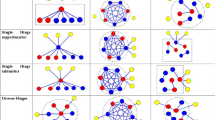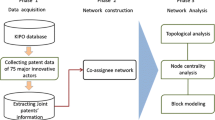Abstract
As national R&D grows in scale, government-funded research institutes (GRIs) are being increasingly criticized for their low research productivity and the role of GRIs itself has become ambiguous. Hence, this study aims to investigate whether GRIs differ from universities or the private sector in terms of technological innovation and if so, how. This study also examines chemical technology as a case study, as technological innovation is active in this field and GRIs are present in relevant areas. Among the research and development projects registered in the National Science and Technology Information Service in South Korea, 4895 projects that used chemical technology were set as analysis targets: 560 projects with GRIs as the research agent, 4097 projects with universities as the research agent and 238 projects with the private sector as the research agent. Of the various indicators of technological innovation, this study examined the overall network structure characteristics and core technologies. The findings are as follows. First, GRIs and universities have similar core technologies, whereas they differ in overall network structure characteristics. Second, GRIs and the private sector have similar overall network structure characteristics, whereas they differ in terms of core technologies. These findings indicate that, at least in chemical technology, GRIs achieve technological innovation in a different form from universities and the private sector. The results of this study will likely provide implications for researchers and policymakers when establishing technological innovation policies for each research agent in the future.

Similar content being viewed by others
Data availability
The datasets used and/or analyzed during the current study are available from the corresponding author upon reasonable request.
References
Abbasi, A., Hossain, L., Uddin, S., & Rasmussen, K. J. R. (2011). Evolutionary dynamics of scientific collaboration networks: Multi-levels and cross-time analysis. Scientometrics, 89(2), 687–710. https://doi.org/10.1007/s11192-011-0463-1
Altaf, A., Hassan, Ie., & Batool, S. (2019). The role of ORIC in the evolution of the triple helix culture of innovation: The case of Pakistan. Technology in Society, 56, 157–166. https://doi.org/10.1016/j.techsoc.2018.09.014
Atay, E. (2012). Innovation actors in South Korea: An analysis of university, industry and government research centers. The Journal of Knowledge Economy & Knowledge Management, 7(2), 175–191.
Basso, F. G., Pereira, C. G., & Porto, G. S. (2021). Cooperation and technological areas in the state universities of São Paulo: An analysis from the perspective of the triple helix model. Technology in Society, 65, 101566. https://doi.org/10.1016/j.techsoc.2021.101566
Breiger, R. L. (1974). The duality of persons and groups. Social Forces, 53(2), 181–190. https://doi.org/10.2307/2576011
Choe, H., & Lee, D. H. (2017). The structure and change of the research collaboration network in Korea (2000–2011): Network analysis of joint patents. Scientometrics, 111(2), 917–939. https://doi.org/10.1007/s11192-017-2321-2
Chung, H. M., Kwon, O. K., Han, O. S., & Kim, H. J. (2020). Evolving network characteristics of the Asian international aviation market: A weighted network approach. Transport Policy, 99, 299–313. https://doi.org/10.1016/j.tranpol.2020.09.002
Conceição, P., Heitor, M. V., Gibson, D. V., & Shariq, S. S. (1998). The emerging importance of knowledge for development. Technological Forecasting and Social Change, 58(3), 181–202. https://doi.org/10.1016/S0040-1625(98)00016-X
Dayton, L. (2020). How South Korea made itself a global innovation leader. Nature. https://doi.org/10.1038/d41586-020-01466-7
Droescher, M. (2018). Chemistry: The driving force for emerging technologies. Chemistry International, 40(4), 14–17. https://doi.org/10.1515/ci-2018-0405
Eom, B. Y., & Lee, K. (2010). Determinants of industry–academy linkages and their impact on firm performance: The case of Korea as a latecomer in knowledge industrialization. Research Policy, 39(5), 625–639. https://doi.org/10.1016/j.respol.2010.01.015
Eslami, H., Ebadi, A., & Schiffauerova, A. (2013). Effect of collaboration network structure on knowledge creation and technological performance: The case of biotechnology in Canada. Scientometrics, 97(1), 99–119. https://doi.org/10.1007/s11192-013-1069-6
Etzkowitz, H. (2003). Innovation in innovation: The triple helix of university–industry–government relations. Social Science Information, 42(3), 293–337. https://doi.org/10.1177/05390184030423002
Etzkowitz, H., & Leydesdorff, L. (2000). The dynamics of innovation: from national systems and “Mode 2” to a Triple Helix of university–industry–government relations. Research Policy, 29(2), 109–123. https://doi.org/10.1016/S0048-7333(99)00055-4
Freeman, L. C. (1978). Centrality in social networks conceptual clarification. Social Networks, 1(3), 215–239. https://doi.org/10.1016/0378-8733(78)90021-7
Guinet, J. (2010). The changing role of government research institutes in innovation systems. STI Policy Review, 1(1), 63–92.
Huang, C., & Wang, Y. (2018). Evolution of network relations, enterprise learning, and cluster innovation networks: The case of the Yuyao plastics industry cluster. Technology Analysis and Strategic Management, 30(2), 158–171. https://doi.org/10.1080/09537325.2017.1297786
IMD. (2021). Competitiveness ranking (Korea Rep.). IMD World Competitiveness Online. Retrieved May 1, 2022, from https://worldcompetitiveness.imd.org/countryprofile/KR/wcy
Jeon, J., Geetha, S., Kang, D., & Narayanamoorthy, S. (2021). Development of the evaluation model for national innovation capability. Technology Analysis and Strategic Management, 34(3), 335–348. https://doi.org/10.1080/09537325.2021.1900808
Kim, H. S. (2019). How a firm’s position in a whole network affects innovation performance. Technology Analysis and Strategic Management, 31(2), 155–168. https://doi.org/10.1080/09537325.2018.1490398
Kim, L. (1997). Imitation to innovation: The dynamics of Korea’s technological learning. Harvard Business Press.
Kim, Y. J., & Lee, D. H. (2020). Technology convergence networks for flexible display application: A comparative analysis of latecomers and leaders. Japan and the World Economy, 55, 101025. https://doi.org/10.1016/j.japwor.2020.101025
Kim, Y. J., & Lee, D. H. (2021). Technology convergence on automotive lightweight materials: Evidence from South Korea. Technology Analysis and Strategic Management. https://doi.org/10.1080/09537325.2021.1973666
KISTEP. (2020). The evaluation of science and technology innovation capacity 2019. KISTEP. Retrieved May 1, 2022, from https://www.kistep.re.kr/boardDownload.es?bid=0047&list_no=36540&seq=11575
Ko, S., Kim, W., & Lee, K. (2021). Exploring the factors affecting technology transfer in government-funded research institutes: The Korean case. Journal of Open Innovation: Technology, Market, and Complexity, 7(4), 228. https://doi.org/10.3390/joitmc7040228
KRICT. (2022). Vision of KRICT. KRICT. Retrieved May 1, 2022, from https://www.krict.re.kr/eng/sub01_02.do
Laursen, K., & Salter, A. (2006). Open for innovation: The role of openness in explaining innovation performance among UK manufacturing firms. Strategic Management Journal, 27(2), 131–150. https://doi.org/10.1002/smj.507
Lee, D. H., Bae, Z. T., & Lee, J. (1991). Performance and adaptive roles of the government-supported research institute in South Korea. World Development, 19(10), 1421–1440. https://doi.org/10.1016/0305-750X(91)90084-U
Lee, J. H. (2018). Principles and methodologies for STI strategy development: Experience and best practices from the Republic of Korea. Asian Journal of Innovation and Policy, 7(3), 411–437. https://doi.org/10.7545/ajip.2018.7.3.411
Lee, K., & Lim, C. (2001). Technological regimes, catching-up and leapfrogging: Findings from the Korean industries. Research Policy, 30(3), 459–483. https://doi.org/10.1016/S0048-7333(00)00088-3
Lee, Y. G. (2012). Strengthening competency linkage to innovation at Korean universities. Scientometrics, 90(1), 219–230. https://doi.org/10.1007/s11192-011-0497-4
Milgram, S. J. P. T. (1967). The small world problem. Psychology Today, 2(1), 60–67.
Mohar, B. (1991). Eigenvalues, diameter, and mean distance in graphs. Graphs and Combinatorics, 7(1), 53–64. https://doi.org/10.1007/BF01789463
Pavitt, K. (1998). Technologies, products and organization in the innovating firm: What Adam Smith tells us and Joseph Schumpeter doesn’t. Industrial and Corporate Change, 7(3), 433–452. https://doi.org/10.1093/icc/7.3.433
Pu, G., Zhu, X., Dai, J., & Chen, X. (2022). Understand technological innovation investment performance: Evolution of industry-university-research cooperation for technological innovation of lithium-ion storage battery in China. Journal of Energy Storage. https://doi.org/10.1016/j.est.2021.103607
Shapiro, M. A. (2012). Receiving information at Korean and Taiwanese universities, industry and GRIs. Scientometrics, 90(1), 289–309. https://doi.org/10.1007/s11192-011-0501-z
Singh, A., Wong, P.-K., & Ho, Y.-P. (2015). The role of universities in the national innovation systems of China and the East Asian NIEs: An exploratory analysis of publications and patenting data. Asian Journal of Technology Innovation, 23(2), 140–156. https://doi.org/10.1080/19761597.2015.1074515
Wasserman, S., & Faust, K. (1994). Social network analysis: Methods and applications. Cambridge University Press.
Wright, M., Clarysse, B., Lockett, A., & Knockaert, M. (2008). Mid-range universities’ linkages with industry: Knowledge types and the role of intermediaries. Research Policy, 37(8), 1205–1223. https://doi.org/10.1016/j.respol.2008.04.021
Yang, M. S. (2016). Development of research topic map for analyzing institute performed R&D projects-based on NTIS data. Indian Journal of Science and Technology, 9, 46. https://doi.org/10.17485/ijst/2016/v9i46/107197
Yim, D. S., & Kim, W. D. (2005). The evolutionary responses of Korean government research institutes in a changing national innovation system. Science, Technology and Society, 10(1), 31–55. https://doi.org/10.1177/097172180401000103
Yoon, J. W. (2014). Evolution of science and technology policy in Korea. Korean Journal of Policy Studies, 29(1), 147–172. https://doi.org/10.52372/kjps29107
Yun, S., & Lee, J. (2013). An innovation network analysis of science clusters in South Korea and Taiwan. Asian Journal of Technology Innovation, 21(2), 277–289. https://doi.org/10.1080/19761597.2013.866310
Acknowledgements
The authors thank Lee Duk Hee for advice on research design and statistical analysis.
Funding
No funds, grants or other support were received.
Author information
Authors and Affiliations
Contributions
The author contributed to the study conception and design. Material preparation, data collection and analysis were performed by the author. The first draft of the manuscript was written by the author. The author read and approved the final manuscript.
Corresponding author
Ethics declarations
Competing interests
The author has no relevant financial or non-financial interests to disclose.
Ethical approval
Not applicable.
Informed consent
Not applicable.
Appendix
Appendix
Chemical technologies in the NSTSC codes.
Research field | Section | Division |
|---|---|---|
Science and technology (nature) | NC. Chemistry | NC01. Physical chemistry |
NC02. Organic chemistry | ||
NC03. Inorganic chemistry | ||
NC04. Analytical chemistry | ||
NC05. Polymer chemistry | ||
NC06. Biochemistry | ||
NC07. Photochemistry | ||
NC08. Electrochemistry | ||
NC09. Nanochemistry | ||
NC10. Interdisciplinary chemistry | ||
NC99. Other chemistry | ||
Science and technology (artificial) | EC. Chemical engineering | EC01. Chemical process |
EC02. Nano-chemical process | ||
EC03. Polymeric materials and process | ||
EC04. Biochemical process | ||
EC05. Fine-chemical process | ||
EC06. General chemical products | ||
EC07. Fiber production | ||
EC08. Dyeing and finishing | ||
EC09. Textile goods | ||
EC10. Safety technology for chemical process | ||
EC11. CBR weapon/fire power ammunition | ||
EC99. Other chemical engineering |
Rights and permissions
Springer Nature or its licensor (e.g. a society or other partner) holds exclusive rights to this article under a publishing agreement with the author(s) or other rightsholder(s); author self-archiving of the accepted manuscript version of this article is solely governed by the terms of such publishing agreement and applicable law.
About this article
Cite this article
Kim, Y.J. Technological innovation in GRIs, universities, and the private sector: evidence from the chemical technology network in South Korea. Scientometrics 128, 5929–5948 (2023). https://doi.org/10.1007/s11192-023-04820-4
Received:
Accepted:
Published:
Issue Date:
DOI: https://doi.org/10.1007/s11192-023-04820-4




